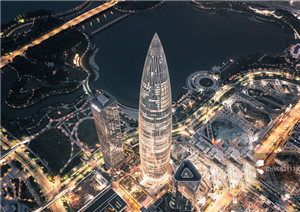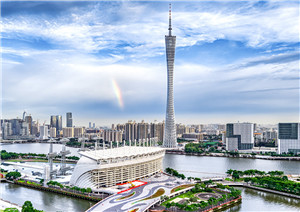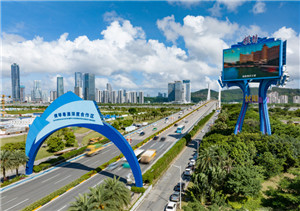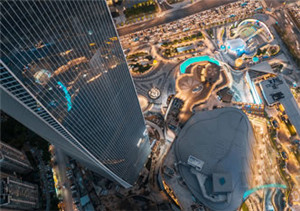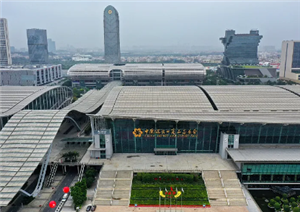
The Cantonese Opera Art Museum in the district. [Photo provided to China Daily]
Since the 1930s, Enning Road in Guangzhou, the capital of Guangdong province, has been synonymous with Cantonese culture. Once a magnet for the brightest stars of Cantonese Opera, the street near the bustling Thirteen Hongs trading area was also home to martial arts schools and traditional medicine clinics.
For 60-year-old Cen Zhaowei, Enning Road holds deeply personal memories. As a boy, he watched his father, Cen Neng — a revered Wing Chun grandmaster known as Sum Nung in Cantonese — teach disciples complex martial arts techniques while running a clinic that treated injuries the traditional way.
The street's architectural charm is unmistakable. Its arcaded buildings blend Baroque flourishes and the design principles of Guangzhou's Xiguan mansions, with high ceilings, deep layouts and ornate Manchurian windows. This style fusion speaks to the city's layered history.
Enning Road's fortunes shifted over the years. Once a thriving cultural hub, it eventually deteriorated into one of Guangzhou's most densely packed areas filled with dilapidated housing.

Arcaded buildings line Enning Road of Guangzhou. [Photo/Xinhua]
In 2016, a preservation plan was set in motion to restore its historical face. That same year, Cen Zhaowei reopened the Guangzhou Cen Neng Wing Chun Heritage Center in its original home.
Around the corner from the center, the newly opened Cantonese Opera Art Museum began training a new generation of performers under the guidance of Tang Peiwen, then a 26-year-old inheritor of Cantonese Opera.
In 2018, President Xi Jinping visited Yongqing Fang, a revitalized section of Enning Road. By then, the neighborhood welcomed studios dedicated to Cantonese porcelain and embroidery, intangible cultural heritage practices that breathed fresh energy into the storied streets.
Today, the Enning Road historical district straddles two worlds — the timeless and the contemporary. Its historical urban fabric remains intact while new businesses — from trendy cafes to creative boutiques — introduce modern vibrancy.
Strolling through the neighborhood, visitors are met by the clang of copper being hammered and the lilting melodies of Cantonese Opera.
On weekends and holidays, the streets teem with life. During this year's National Day holiday, Yongqing Fang drew over 893,000 visitors, a striking 78.4 percent increase from the previous year — a testament to the allure of Enning Road's past and its reinvention for the future.

Old photos of martial arts superstar Bruce Lee decorate the residence of his family in the Enning Road historical district. [Photo provided to China Daily]
Retired resident Liang Jinsheng has seen how the neighborhood has evolved over the past decade.
The 63-year-old's ties to the area run deep as his family has lived here for over three centuries. Less than a kilometer from Enning Road is the Leung (an alternate spelling of Liang) Ancestral Hall, a shrine that reflects the family's enduring connection to the land.
"The arcaded buildings on Enning Road are quintessentially Xiguan," he says. "Shops fill the ground floors and the covered walkways provide shelter from the rain and shade from the sun, a practical elegance that defines the area."
For Liang, the restoration has brought a sense of pride. He speaks of relatives and friends from abroad who now make a pilgrimage to the neighborhood. "They come to see the arcades, explore the Xiguan mansions and search for a connection to their roots," he says.
But Liang also remembers when the small river running through the area was more an eyesore than an attraction — a murky, foul-smelling ditch. Now, after being cleaned up, the river banks are a place of calm where he and his wife stroll daily, often with their young grandsons who are 3 and 5.
"It used to be chaos along the river — tangled wires, pipes everywhere," he says. "Now, it's been tidied up. Neighbors gather to soak up the sun, go for walks and enjoy the space."
The changes have resulted in more than just local appreciation. Visitors now flock to Enning Road, particularly to see the "Moon Bridge". The semicircular arch, lit up at night, casts a glowing reflection on the water, creating the illusion of a suspended crescent moon. The bridge has become a magnet for photographers and tourists, especially during the Mid-Autumn Festival.
"In recent years, tens of thousands of people have come during the festival to photograph the bridge," Liang says.

A highlighted arch bridge dubbed the "Moon Bridge" outside the district's Cantonese Opera Art Museum. [Photo provided to China Daily]
Jiang Weihui, a researcher with the housing and urban-rural development bureau of Liwan district, where Enning Road is located, states that preservation efforts began in 2006.
"Our renovation projects focus on historical and cultural preservation, including the Liwan water system, the Cantonese Opera Art Museum and broader district development," he says.
The official preservation plan for Enning Road was launched in 2018. Jiang emphasizes the team's sensitive approach to preserving traditional Lingnan (southern China) architectural elements and minimizing demolition.
"It's a painstaking process," Jiang says. "We reinforce existing structures and preserve their original appearance." preservation efforts began in 2006.
"Our renovation projects focus on historical and cultural preservation, including the Liwan water system, the Cantonese Opera Art Museum and broader district development," he says.
The official preservation plan for Enning Road was launched in 2018. Jiang emphasizes the team's sensitive approach to preserving traditional Lingnan (southern China) architectural elements and minimizing demolition.
"It's a painstaking process," Jiang says. "We reinforce existing structures and preserve their original appearance."
Enning Road was once one of Guangzhou's aging neighborhoods. Today, it is a vibrant hub for young people, with trendy stores and coffee shops lining the streets.
In 2020, Yongqing Fang became home to Guangzhou's first intangible cultural heritage-themed area and opened studios for masters of heritage.
"We introduced heritage studios with favorable rent policies as a platform for masters to display their work," Jiang says. "This initiative connects young people with intangible heritage while encouraging the adaptation of products for modern tastes."
In August, Enning Road was recognized by the Ministry of Housing and Urban-Rural Development for its exemplary preservation practices. Jiang believes the district's pilot projects offer valuable lessons for other historical areas in Guangzhou.
Plans are also in place to create a pedestrian system connecting Enning Road with neighboring districts using the nearby river to preserve and revitalize the area's streets and paths, Jiang says.

Cen Zhaowei runs a Wing Chun heritage center in the district, where he holds deeply personal memories. [Photo provided to China Daily]
Reviving history
Cen Zhaowei, who grew up in the Enning Road historical district, returned in 2016. His goal is to inspire more young people to practice Wing Chun — not just for physical fitness but as a way of life.
"Wing Chun is about going with the flow, balancing yin and yang. It's not only a philosophy but a lifestyle," Cen Zhaowei explains.
He sees his studio in Enning Road as the ideal setting to blend tradition with modernity, making it a strong base for developing Guangzhou's martial arts culture.
Cen Zhaowei began practicing Wing Chun when he was 12 and says that the neighbors have memories of people practicing it. Now, he has partnered with elementary schools to teach Wing Chun to children.
"Learning martial arts is challenging and mastering Wing Chun is even harder," Cen Zhaowei says, adding that the practice engages the eyes, hands, ears, waist and mind, offering physical and mental benefits.
To make the lessons more engaging, he allows students to practice with a wooden dummy and experiments by adding features to the dummy to make training more fun. "As inheritors, we must pass this tradition down through generations," he says.
Like Wing Chun, Cantonese Opera is also experiencing a revival on Enning Road thanks to the opening of the Cantonese Opera Art Museum in 2016. Once a gathering place for great performers, the district now attracts a new generation of talent.
"Cantonese Opera is a pillar of Lingnan culture and Liwan is its birthplace," Tang Peiwen says.
At 34, Tang is leading this resurgence. A celebrated performer and the first inheritor of Cantonese Opera from the post-1990 generation in Liwan district, Tang also oversees a children's heritage program at the museum. Since its launch eight years ago, she has trained over 400 students through partnerships with local elementary schools.
While vocal ability matters, Tang values the passion for Cantonese opera and an interest in preserving traditional culture above all. "My goal is to ensure that this art form takes root in the children's hearts and spreads to their families and communities," she says.




